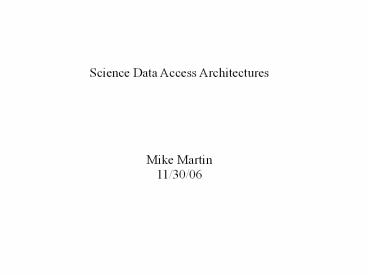Science Data Access Architectures - PowerPoint PPT Presentation
1 / 13
Title:
Science Data Access Architectures
Description:
Science Data Access Architectures Mike Martin 11/30/06 ... First step, look at middleware architectures. For several selected middleware architectures: ... – PowerPoint PPT presentation
Number of Views:189
Avg rating:3.0/5.0
Title: Science Data Access Architectures
1
Science Data Access Architectures Mike
Martin 11/30/06
2
- Background
- Proposed to Ed to survey information system
capabilities across NASA disciplines. Where are
they now, where are they going? - Especially interested in capabilities and tools
that could answer requirements in MRO User
Scenario Document by Ray Arvidson and Jim Murphy,
something of a PDS vision statement. - First step, look at middleware architectures.
3
- For several selected middleware architectures
- Describe how each scheme works.
- Compare the different approaches to common
problems. - Identify any exemplary or noteworthy features
of the various schemes. - It quickly became apparent that there was a lot
of excitement about Service Oriented Architecture
(SOA) and Web Services. - Commoditize information and computer resources
for autonomous consumption. - SOAP messages, WSDL service contracts and UDDI
service registries.
4
- Selected Systems include
- Open GIS Consortiums Open Web Services (OWS),
servers for digital maps, images and GIS data. - International Virtual Observatory Alliance
(IVOA) registry and data access services for
astrophysics data. - Planetary Data Systems implementation of
Object Oriented Data Technology (PDS-OODT) for
query, profile and product servers. - Earth Observing System Clearinghouse (ECHO) for
a central catalog identifying earth science data
and services.
5
Open Web Services (OWS)
6
International Virtual Observatory Alliance (IVOA)
7
PDS Object Oriented Data Technology (OODT)
8
EOS Clearinghouse (ECHO)
9
Feature Comparison
10
Service Summary
11
- Highlights
- OWS layered discovery model (GetCapabilites(),
DescribeRecords(), GetRecords() and harvesting
capability - IVOA cone search, VOTable, summer studies.
- Web Services orientation in ECHO and IVOA.
- Lowlights
- No standard XML query language
- Mixing service registry and catalog functions.
12
- Conclusions
- OWS - Elegant architecture. Now someone needs
to make it work, especially the catalog servers. - IVOA - Great architectural vision.
Interesting data oriented service approach.
Seems to have widespread community support. - PDS-OODT - Great job implementing product
servers, now do profile servers at every node.
IPDA efforts are adding support for VOTable and
GetCapabilites features. - ECHO - Wide range of services exposed via
API. Still seems immature, despite being on
Version 8. Will central spatial database be a
success?
13
- Next steps
- Get feedback from you folks and others at
tahoe_mike_at_sbcglobal.net - Should other schemes be included (the Grid,
Opendap)? - Other analysis/observations based on this
information? - Is there hope for long term convergence (earth,
space, planetary and astrophysics all using same
service architectures)?































